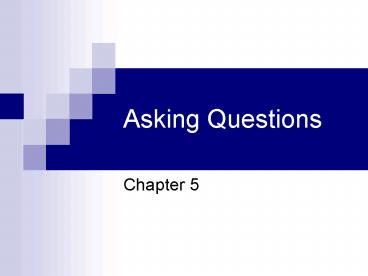Asking Questions - PowerPoint PPT Presentation
1 / 25
Title:
Asking Questions
Description:
Avoid double-barrelled questions. people may have different answers to each part ... especially double negatives, which can be confusing. Don't ask two ... – PowerPoint PPT presentation
Number of Views:27
Avg rating:3.0/5.0
Title: Asking Questions
1
Asking Questions
- Chapter 5
2
- How can researchers design surveys and
questionnaires that ask good questions?
3
Using Open Questions
- Advantages
- respondents answer in their own terms
- allow for new, unexpected responses
- Exploratory
- generate fixed answer questions
4
- Disadvantages
- time-consuming for interviewer and respondent
- difficult to code
- more effort required from respondent
- interviewer variation in recording answers
5
Using Closed Questions
- Advantages
- quicker and easier to complete
- better response rate and less missing data
- easy to process data, often pre-coded
- easy to compare answers
- intercoder reliability
6
- Disadvantages
- restrictive range of answers
- no spontaneity
- difficult to make fixed choice answers exhaustive
- respondents may interpret questions differently
7
Open versus Closed Questions
- Canadian Gallup poll open question
- What is the most important problem facing the
country today? - Canadian Gallup poll closed question
- What is the most important problem facing the
country today? Please choose from crime, debt,
pollution, health care, immigration, inflation,
unity, taxes, trade, unemployment, Other (please
specify), or Dont know
8
Coding
- Pre-coding
- closed questions in surveys are assigned
numerical codes - Post-coding (for open questions)
- use a coding frame
- 1. categorize unstructured material
- 2. assign a numerical code to each category
9
- Rules for coding (Bryman Cramer, 2004)
- categories must not overlap
- cover all possible answers
- consistent over time and between coders
10
Types of Questions
- Personal factual questions
- Factual questions about others
- Informant factual questions
- Questions about
- attitudes
- beliefs
- normative standards and values
- lay knowledge
11
Designing Questions General Rules
- Remember your research questions
- Decide exactly what you want to find out
- Imagine yourself as a respondent
- how would you answer the questions?
- identify any vague or misleading questions
- think about questionnaire length, style and
attractiveness
12
Designing Questions Specific Rules
- Avoid ambiguous terms
- often, regularly, frequently, have
- Avoid double-barrelled questions
- people may have different answers to each part
- no necessary correspondence between parts
- e.g. How much time do you spend on going to
concerts and the cinema?
13
- Avoid long questions
- Avoid very general questions
- difficult to answer because they lack a frame of
reference - e.g. How happy is your family life?
14
- Avoid leading questions
- suggest that a particular response is desired
- e.g. Do you think that tuition fees make
students less keen to go to university? - Avoid negative terms (not, never)
- especially double negatives, which can be
confusing
15
- Dont ask two questions in one
- Which political party did you vote for at the
last election? First, you must establish whether
respondent voted at all. - Dont ask for opinions about several things at
once - Avoid technical terms, jargon and acronyms
16
- Ensure that respondents have the requisite
knowledge - are the questions meaningful?
- Maintain symmetry between closed questions and
responses - Create balance between positive and negative
fixed responses to a question - avoid bias
17
- Dont rely on respondents memory
- Be sure to include a dont know
option
18
Common Mistakes When Designing Questions
- Excessive use of open questions
- Excessive use of yes/no questions
- No instructions about how to indicate answers
- tick box, circle, delete
- Overlapping categories
19
- More than one answer may be applicable
- Answers do not correspond to the question
20
Bias in Question Wording
- Are you more in favour of
- Assistance to the poor or Welfare?
- Tax relief or Tax cuts?
- Estate tax or Death tax?
- Halting rising crime or Law enforcement?
- Dealing with drug addiction or Drug
rehabilitation?
21
Vignette Questions
- Present respondents with a scenario
- Ask them how they would respond or what they
think the characters should do - Anchors opinions and choices in a concrete,
specific context (may be easier to answer) - Useful for sensitive topics (Finch, 1987)
- less threatening imaginary characters suggest
social distance from respondent
22
Piloting and Pre-testing Questions
- Check that the research instrument works
- gain practice at using interview schedule
- does each question flow smoothly on to the next?
- identify vague or confusing questions
- remove any questions that received uniform
responses
23
- Open questions can generate fixed choice answers
to include in the final study - Pilot respondents should not be in final sample
24
Using Existing Questions
- Common practice in survey research
- Questions have already been piloted
- Known properties of reliability and validity
- Helps you to draw comparisons with other studies
- Question banks
- repositories of questions used in previous survey
25
Websites
- On questionnaire construction
- http//www.statcan.ca/english/edu/power/ch2/questi
onnaires/questionnaires.htm - List of Statistics Canada surveys
- http//www.statcan.ca/english/sdds/index.htm































